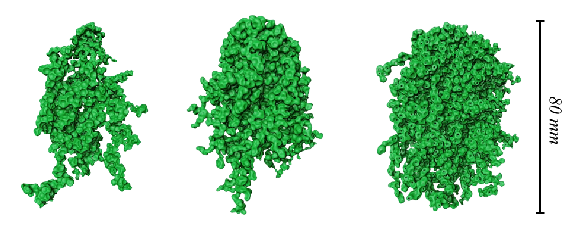Objective:
We will characterize and map the different regimes in transient and steady-state two-phase flow. We will relate the spatial scaling behavior, the characteristic length scales, and the burst dynamics of immiscible two-phase flow to the problem of upscaling. The role of film current will be elucidated for immiscible two-phase current. Experimental results will be compared with the equations based on non-equilibrium thermodynamics developed under WP1.

Images from a 3D optical scanner of glycerol invading a less viscous rapeseed oil. Flow rates, from left to right: Q = 0.1, 0.5, and 1.0 ml/min. The structures consist of a compact region, surrounded by thin ”fingers”.
Description:
One of the most challenging and exciting aspects of porous media science is the tremendous range of scales. The size of hydrocarbon reservoirs or water aquifers is measured in kilometers. Pores have a diameter of 10 to hundred micrometers, or seven orders of magnitude smaller. How can we infer large-scale flow dynamics from small-scale physics? The structure and dynamics of drainage in porous media depend on several parameters such as densities and viscosities of the fluids, surface tension, wetting properties, and the geometry of the porous medium. The various forces at play, viscous, gravitational, and capillary forces dominate at different length scales, and their interplay gives rise to separate regimes. In our experimental work we will focus on a bottom-up approach to investigate the scaling of the structures within the different regimes and the characteristic length scales describing the crossover between these regimes. We have measured the capillary pressure fluctuations and the Haines jumps, as well as how these fluctuations relate to dissipation at larger scales. Experiments will be carried out in both transient flow regimes and the so-called steady state regime, using either quasi two-dimensional or three-dimensional model systems. The quasi two-dimensional models are either glass bead models, or 3D printed transparent models where the local geometry can be controlled. To perform three dimensional experiments we have developed and optical scanner based on optical index matching and fluorescence
Deliverables
Based on the spatial scaling and characteristic length scales of the different scaling regimes, develop a theory for upscaling and explain how the burst activity relates to surface energy and dissipation.
Use the results from experiments with film flow to calibrate a network model including film flow.
Elucidate and determine the relaxation properties and characteristic length scales of transient and steady state behavior in porous media.
To describe and map the different regimes in transient and steady state two-phase flow. To check the thermodynamic equations derived under WP1.
We will deliver a state of the art 3D optical scanner.
Investigators
Principal Investigator for Research Theme 3: Professor Knut Jørgen Måløy.
Partners:
Profs Dag Dysthe, Eirik Grude Flekkøy, Alex Hansen, Bjørnar Sandnes, Stéphane Santucci, Mickael Bourgoin, Ole Torsæter, Carl Fredrik Berg, Renaud Toussaint, Gerhard Schäfer, Per Arne Rikvold, Dick Bedeaux, Signe Kjelstrup
Postdoctoral Fellows and Researchers: Marcel Moura; Fredrik Kvalheim Eriksen, Mihailo Jankov, Antoine Turquet
PhD students:Joachim Falck Brodin, Louison Thorens, Monem Ayaz
Selected articles:
- Joachim Falck Brodin, Per Arne Rikvold, Marcel Moura, Renaud Toussaint and Knut Jørgen Måløy, Competing gravitational and viscous effects in 3D two-phase flow investigated with a table-top optical scanner. Accepted in Frontiers in Physics (2022)
- Fredrik Kvalheim Eriksen, Marcel Moura, Mihailo Jankov, Antoine Turquet, and Knut Jørgen Måløy. The transition from viscous fingers to compact displacement during unstable drainage in porous media. Phys. Rev. Fluids. 7, 013901 (2022)
- Knut Jørgen Måløy, Marcel Moura, Alex Hansen, Eirik Grude Flekkøy, and Renaud Toussaint. Burst Dynamics, Upscaling and Dissipation of Slow Drainage in Porous Media. Front. Phys. 9:796019. doi: 10.3389/fphy.2021.796019 (2021)
- Thorens, K. J. Måløy, M. Bourgoin, and S. Santucci. Magnetic Janssen Effect, Nature Communications, 12:2486, https://doi.org/10.1038/s41467-021-22722-y, (2021)
- Ayaz, M., Toussaint, R., Schäfer, G., & Måløy, K. J. Gravitational and finite-size effects on pressure saturation curves during drainage. Water Resources Research, 56, e2019WR026279. https://doi.org/10. 1029/2019WR026279 (2020)
- Moura M., Flekkøy E.G., Måløy K.J., Schafer G., and Toussaint R., Connectivity enhancement due to film flow in porous media, accepted in Phys. Rev. Fluids 4, 094192 (2019)
- Moura M., Måløy K.J., Flekkøy E., and Toussaint R., Verification of a dynamic scaling for pair correlation function during the slow drainage of a porous medium. Phys. Rev. Lett. 119, 154503 (2017).2.
